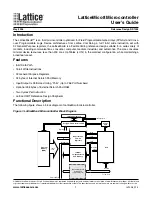
25
FX
3U
/FX
3UC
Series Programmable Controllers
Programming Manual - Basic & Applied Instruction Edition
2 Overview (Sequence Program)
2.1 Introduction of Convenient Functions
1
In
troduct
io
n
2
Ov
e
rv
ie
w
3
In
st
ru
ct
ion
Li
st
4
D
evi
ce
s
in
De
ta
il
5
Speci
fied t
h
e
D
evi
ce &
C
onst
a
nt
6
Bef
o
re
Pr
ogr
a
m
m
ing
7
Bas
ic
In
st
ru
cti
o
n
8
FNC0
0
-FNC0
9
P
ro
g
ra
m F
lo
w
9
FNC1
0
-FNC1
9
M
ov
e
&
C
om
par
e
10
FNC
20-
FNC
2
9
Ar
ith.
&
Logi
c
O
per
at
io
n
5. Three types of "interrupt" functions for receiving short-period pulses and priority
processing
→
Refer to Chapter 35.
1) Input interrupt
Signals from specific input relays are monitored. At the rising edge or falling edge of the monitored input,
a specified interrupt routine is executed with highest priority.
2) Timer interrupt
Specified interrupt routines are executed with highest priority at every specified time.
3) Counter interrupt
Depending on the present value of a high speed counter, a specified interrupt routine is executed with
highest priority.
2.1.2
Convenient functions for output processing
1. "I/O refresh" function for outputting the latest input information
The input terminal information of the PLC in the batch refresh method is input at one time by the input image
memory before operation in the step 0. The output information is output at one time when END instruction is
executed.
I/O refresh instruction can get the latest input information and immediately output the operation result during
sequence operation.
→
Related instruction: Refresh REF (FNC 50)
2. "Pulse output" function for pulse train output control
→
Related instructions: Pulse Y Output PLSY (FNC 57) and
Acceleration/Deceleration Setup PLSR (FNC 59)
3. "Positioning" function for positioning control
→
Related instructions: DOG Search Zero Return DSZR (FNC150),
Interrupt Positioning DVIT (FNC151), Zero Return (FNC156),
Variable Speed Pulse Output PLSV (FNC157),
Drive to Increment DRVI (FNC158) and
Drive to Absolute DRVA (FNC159)
2.1.3
Functions for supporting sequence control
1. "Constant scan" mode for making the operation cycle of the PLC constant
The operation cycle in the PLC adopting the cyclic operation method varies depending on the contents of the
program execution.
In the constant scan mode (M8039 and D8039), the operation cycle can be made constant. As a result,
instructions executed in synchronization with the operation can be processed in a constant cycle.
2. "All outputs disable" mode for turning OFF all output signals
When the special auxiliary relay M8034 is driven, the output latch memory is cleared. Accordingly, all output
relays (Y) turn OFF while the PLC is continuing its operation.
However, the status of output relays (Y) in each device image memory is not cleared. As a result, when
devices are monitored using a programming tool, they may be regarded as the ON status.
3. "Memory hold stop" function for holding the output status during the RUN mode even in the
STOP mode
When the special auxiliary relay M8033 is driven, the PLC is stopped while the output status during the RUN
mode is held.















































